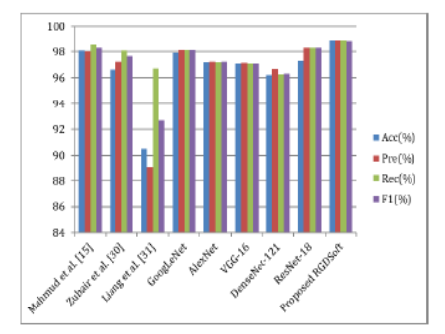


Indian Journal of Science and Technology
DOI: 10.17485/IJST/v15i38.1269
Year: 2022, Volume: 15, Issue: 38, Pages: 1900-1906
Original Article
Kushagra Agrawal1,2, Rajneesh Kumar1*, Shaveta Jain2
1Department of CSE, M.M. Engineering College, Maharishi Markandesh (Deemed to be
University) Mullana, Ambala, India
2Department of AIT-CSE, University Institute of Engineering Chandigarh University, Gharuan,
Mohali, Punjab, India
*Corresponding Author
Email: [email protected]
Received Date:16 June 2022, Accepted Date:30 August 2022, Published Date:14 October 2022
Objectives : To propose an ensemble machine learning model for early identification of COVID-19 and pneumonia lung infections by analyzing the chest X-ray images. Methods: RGDSoft model is proposed for image classification which is a soft voting ensemble deep transfer learning strategy with pre-trained classifiers ResNet-18, GoogLeNet, and DenseNet-121. The model is tested on COVID-19 dataset having 1143 positive COVID-19, 1341 normal, and 1345 pneumonia images, and the Kermany dataset which has 5856 chest X-ray images divided into two groups: ”Pneumonia” and ”Normal”. Out of these image-set 80% of images are used for training and 20% for testing purposes. To demonstrate the efficiency of the proposed model, python is used for implementation. Performance results are evaluated and compared with the existing pre-trained models like GoogLeNet, ResNet18 and DensNet121. Findings: Efficiency of the proposed ensemble model is achieved with 98.1% accuracy level, 98.8% precision, 98.8% recall on kermany dataset whereas 94% accuracy, 96% precision and 96% recall on COVID-19 dataset which is optimum as compared with the most state-of-art models discussed in literature. Novelty: According to the findings of the comprehensive study, the proposed RGDSoft model not only outperforms most of the classifiers like GoogLeNet, ResNet18 and DenseNet121 in terms of combinations of accuracy, precision and recall but is so generic model which shows very good results on different datasets.
Keywords: Machine Learning; Deep Learning; Covid19; Pneumonia; xray images; googlenet; resnet18; densenet121; ensemble
© 2022 Agrawal et al. This is an open-access article distributed under the terms of the Creative Commons Attribution License, which permits unrestricted use, distribution, and reproduction in any medium, provided the original author and source are credited. Published By Indian Society for Education and Environment (iSee)
Subscribe now for latest articles and news.